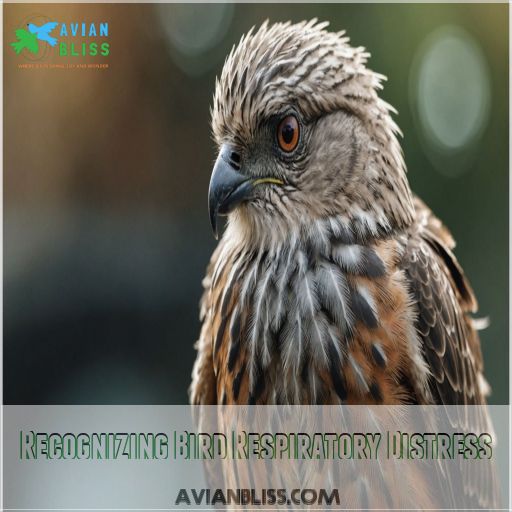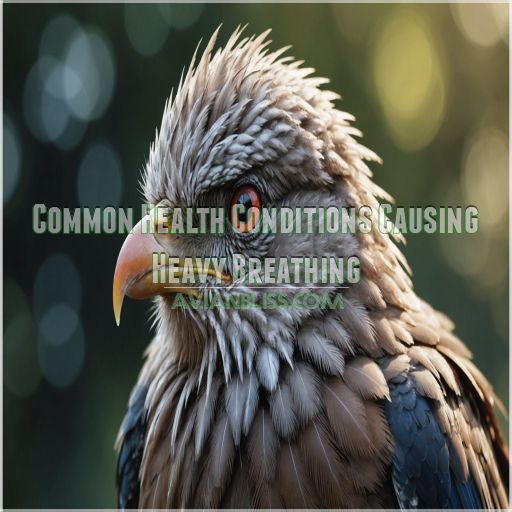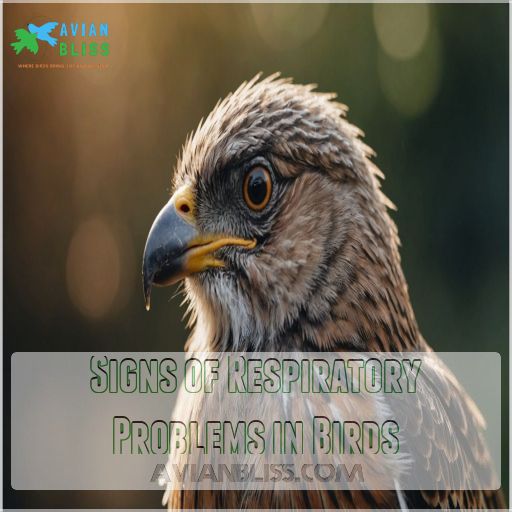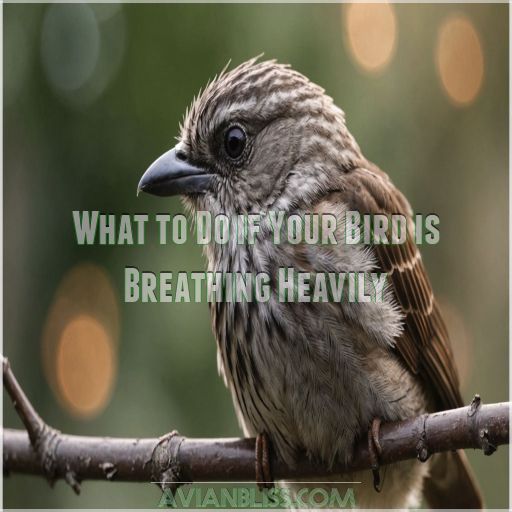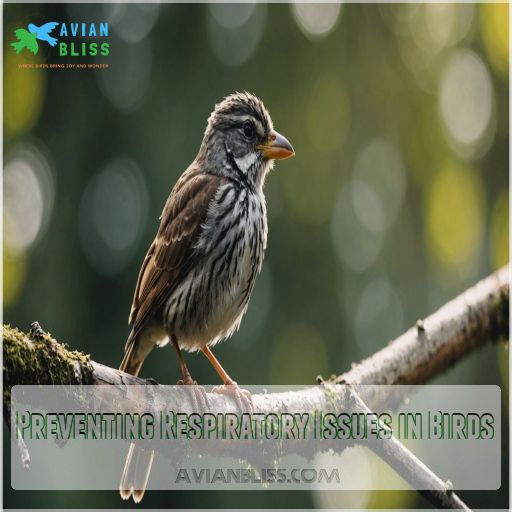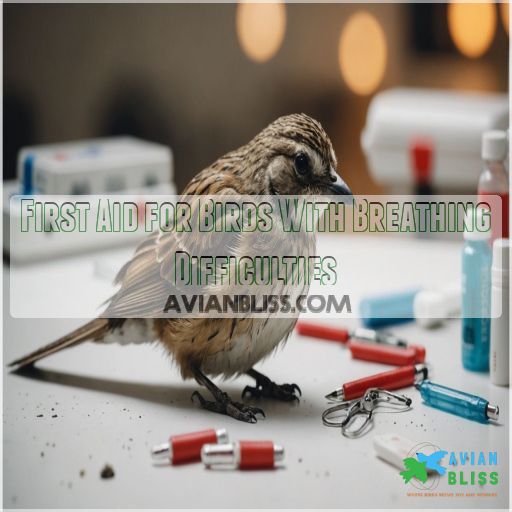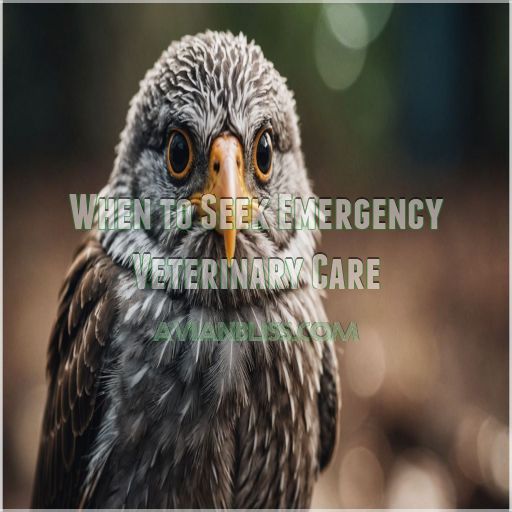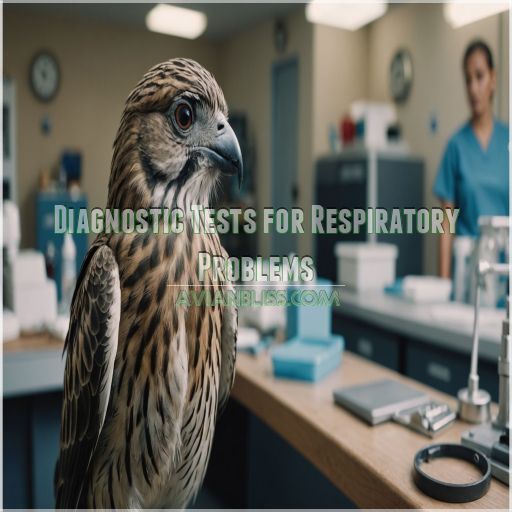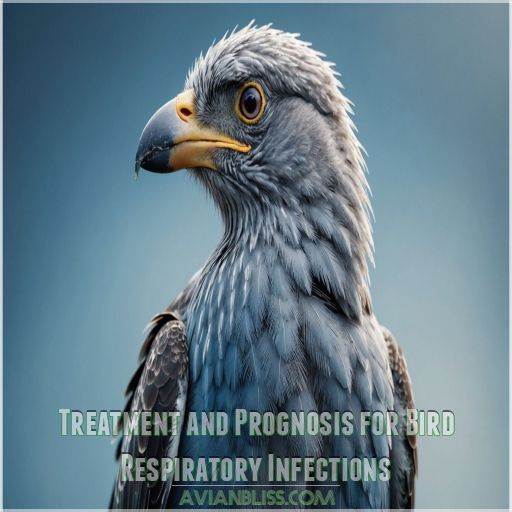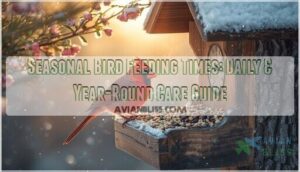This site is supported by our readers. We may earn a commission, at no cost to you, if you purchase through links.

Keep your bird calm and away from any irritants while you get them to an avian vet ASAP. They’ll need a thorough checkup to pinpoint the problem and start treatment.
With prompt care, most bird breathing troubles can be resolved, but delay can be dangerous. So if you spot your bird panting, don’t wait – get them the help they need to get back to their healthy self.
Your vet’s got your back, and so do I.
Table Of Contents
- Key Takeaways
- Recognizing Bird Respiratory Distress
- Causes of Heavy Breathing in Birds
- Common Health Conditions Causing Heavy Breathing
- Signs of Respiratory Problems in Birds
- What to Do if Your Bird is Breathing Heavily
- Preventing Respiratory Issues in Birds
- First Aid for Birds With Breathing Difficulties
- When to Seek Emergency Veterinary Care
- Diagnostic Tests for Respiratory Problems
- Treatment and Prognosis for Bird Respiratory Infections
- Frequently Asked Questions (FAQs)
- Why is my bird breathing so much?
- How do you know if a bird has a breathing problem?
- What causes labored breathing in birds?
- How do you help a bird breathe?
- Why is my bird breathing so heavily?
- Why does my bird look like it’s gasping for air?
- What does it mean when my bird is panting?
- How do you know if a bird has labored breathing?
- How does avian influenza affect bird respiratory health?
- Can backyard poultry owners reduce AI risk?
- What biosecurity measures prevent disease spread?
- Is eating properly cooked poultry completely safe?
- How do hunters handle wild birds safely?
- Conclusion
Key Takeaways
- If you notice your feathered friend panting as if they’ve just finished a marathon, don’t ignore it – heavy breathing in birds can signal serious respiratory issues that require immediate attention.
- Keep an eye out for telltale signs like tail bobbing, open-mouth breathing, or wheezing sounds – these are your bird’s way of signaling that something’s not right with their breathing.
- When in doubt, get your bird to an avian vet as soon as possible. Quick action can be the difference between a simple fix and a more serious health crisis – think of it as CPR for their health and your peace of mind.
- Prevention is better than cure, so create a bird-friendly environment by maintaining good air quality, offering a balanced diet, and scheduling regular check-ups. Your bird will thank you by breathing easily and serenading you with chirps instead of wheezes.
Recognizing Bird Respiratory Distress
When your bird starts sounding like it’s got a tiny harmonica stuck in its throat, it’s time to pay attention to its breathing.
Quick action can mean the difference between a simple cold and a serious health issue, so don’t wait to see if it will pass.
Common Causes of Bird Coughing
When your bird’s coughing, it’s like they’re dropping hints about what’s bugging them.
- Dust mites: These tiny nappers love dusty corners—make cleaning a habit!
- Viral infections: They spread fast and have your bird feeling under the weather.
- Fungal exposure: Sneaky fungi can invade your bird’s space and cause respiratory distress.
If symptoms persist, consult an avian veterinarian.
Symptoms of Bird Respiratory Distress
Your bird’s breathing may sound labored, with open-mouth panting, tail bobbing, and wheezing or clicking noises.
They may also appear lethargic and ruffled.
These are signs of respiratory distress that require urgent veterinary attention.
Don’t wait – get your feathered friend checked out right away to identify the underlying cause and start treatment.
Importance of Immediate Veterinary Attention
Don’t wait – if your feathered friend is breathing heavily, seek immediate veterinary attention. Delayed treatment can lead to severe consequences, even death.
Avian respiratory distress is a critical medical emergency requiring prompt professional assistance.
Rapid intervention is essential to address potential causes like air sacculitis or air sac mites.
Causes of Heavy Breathing in Birds
Heavy breathing in your bird can be worrying, but understanding some common causes can help you respond quickly.
From respiratory infections and airborne irritants to heart problems and heat stress, several factors might be at play.
So keeping an eye on your feathered friend is key, especially in cases of heat stress.
Respiratory Infections
Bird respiratory infections can be sneaky, but knowing the signs can save a life.
Infections in the lungs or air sacs can cause difficulty breathing.
- Increased respiratory effort, often with an up-and-down bob of the tail with each breath.
- Watery eyes, sneezing, wheezing, coughing, and nasal discharge.
- Open-mouth breathing, tail bobbing, and a voice change.
Early warning signs help your bird’s healthcare provider identify contagious pathogens and provide immune system support with effective bird treatment options.
Airborne Irritants
Stepping into a dusty environment or breathing in fumes from scent candles, chemical cleaners, or aerosol sprays can be hazardous to your feathered friend’s health.
As a bird owner, make sure your bird’s air is clean and free from toxins.
Opt for bird-safe alternatives to maintain a healthy atmosphere for your bird’s well-being.
Allergies
While airborne irritants can be a culprit, allergies are another common cause of heavy breathing in birds.
Allergens like feathers, dust, and pollen can trigger reactions, leading to respiratory issues.
If you suspect allergies, consider diet modifications and consult a veterinarian about antihistamine use to alleviate symptoms.
Heart Problems
One common cause of heavy breathing in birds is heart problems, which can be life-threatening if left untreated.
Some heart issues to look out for in your bird include:
- Heart murmurs, often caused by cardiomyopathy
- Diet impacts heart health, with a balanced diet essential for heart function
- Stress and heart health are closely linked, so reducing stress is key
- Regular exercise for birds can help maintain heart health
Heat Stress
High temperatures can send your feathered friend’s body into overdrive, causing heat stress.
As the air temperature and humidity rise, your bird’s core body temperature increases, leading to fatal temperatures (Source).
Keep your bird cool by providing fresh water, ventilation, and a balanced diet that meets their hydration needs and prevents overheating.
Common Health Conditions Causing Heavy Breathing
When your bird starts breathing heavily, it might be dealing with health issues like air sacculitis, heart disease, pneumonia, or even hidden tumors.
Don’t panic, but it’s time to put on your detective hat and figure out which of these sneaky culprits is affecting your feathered friend.
Air Sacculitis
Air sacculitis, an inflammatory condition, can affect your bird’s respiratory system, causing labored breathing, coughing, and sneezing.
This common health condition is often caused by bacterial or fungal pathogens, such as Aspergillosis.
If you suspect air sacculitis, consult a veterinarian, who may use radiography and endoscopy for diagnosis.
Heart Disease
When your bird’s heart isn’t working properly, it can be a real challenge to breathe. * Heart disease symptoms in birds can be tricky to spot, but common signs include labored breathing, lethargy, and a blue-tinged beak or feet.
- Your bird’s heart health is essential to their overall well-being.
- Avian heart disease can be caused by genetics, diet, or other health conditions.
- Regular check-ups with a veterinarian can help prevent heart disease in your feathered friend.
Pneumonia
Just like heart disease, pneumonia can be a silent killer in birds, causing heavy breathing and distress.
Bacterial pneumonia, viral pneumonia, aspiration pneumonia, interstitial pneumonia, and fungal pneumonia are common types.
If you suspect your bird has pneumonia, seek immediate veterinary attention, as prompt treatment can save its life.
Tumors or Growths
How can tumors or growths affect your bird’s breathing?
In rare cases, tumors or growths can develop in a bird’s respiratory system, causing heavy breathing, labored respiration, and coughing.
Types of tumors include adenocarcinomas and squamous cell carcinomas .
Growth causes may be linked to exposure to secondhand smoke or other environmental factors.
Signs of Respiratory Problems in Birds
When your bird sneezes like it’s auditioning for a soap opera, or starts making strange wheezing sounds, it’s probably not doing a comedy routine.
These quirky behaviors might actually be signs of respiratory problems, so it’s time to pay attention and maybe give the vet a call.
Sneezing and Coughing
Noticing your bird sneeze or cough might feel like watching a sneezy soap opera unfold, but it often signals respiratory woes.
Allergies, dust, or even bird flu can be the culprits.
Prevention includes reducing irritants and maintaining hygiene, while treatment varies.
Always consult your vet to shape your feathered friend’s drama-free ending (Source).
Nasal Discharge
Your bird sneezes, now what’s next? Look out for nasal discharge. It might show a deeper respiratory problem if you notice unusual discharge colors or types.
- Watch for clear or colored mucus.
- Check frequency of nasal secretions.
- Be alert to any changes in behavior.
- Clean the bird’s nostrils regularly.
- Seek veterinary advice for discharge treatment and prevention.
Labored Breathing
Dealing with nasal discharge, it’s hard to shake the worry that something’s amiss with your bird.
Labored breathing, often seen with a telltale tail bob, is another sign of respiratory issues.
It could be anything from infections to airborne irritants affecting your feathered friend.
When you spot this, it’s time to seek treatment to keep them safe.
Wheezing or Noisy Breathing
If you hear wheezing sounds from your bird, it might be having respiratory issues. Identifying wheezes is key for your bird’s well-being.
- Causes of wheezing include infections or obstructed airways.
- Notice any noisy breathing?
- Consider consulting a vet.
- Treating wheezing early can make a world of difference.
A stitch in time saves nine, right?
Tail Bobbing
A bird’s tail movement can reveal a lot about its respiratory health.
Unlike wheezing or noisy breathing, tail bobbing is a subtle sign that your bird may be having trouble breathing.
A slight tail bob is normal, but a pronounced one can indicate respiratory illness, as the tail muscles work harder to help the bird breathe.
What to Do if Your Bird is Breathing Heavily
If your bird’s panting like it’s run a marathon, it’s time to act fast. Get them settled in a calm spot, tweak the temperature, and call the vet pronto.
Isolate Your Bird
Now that you’ve identified the signs of respiratory problems in your bird, it’s time to take action.
Move your bird to a safe location, creating an isolation environment that minimizes stress.
Provide a stress-free zone with temporary housing, ensuring temperature control and a safe distance from other birds to prevent disease transmission.
Adjust Temperature and Humidity
Your bird’s comfort zone is between 60-80°F (15-27°C) with an ideal humidity range of 40-60%.
To adjust the temperature and humidity, make sure there’s good airflow and consider using a humidifier or dehumidifier.
Sudden temperature fluctuations can stress your bird, so monitor the humidity levels closely to prevent respiratory distress.
Provide Fresh Air
Having adjusted the temperature and humidity in your bird’s environment is just the first step.
To help your bird breathe more easily, you also need to make sure they’re getting enough fresh air.
- Open windows for air circulation
- Use fans to increase air movement
- Place the cage near an open window
- Avoid burning candles or strong-smelling cleaning products
- Provide a well-ventilated space with good air quality to help your bird feel better.
Offer Water
Dehydration can exacerbate respiratory issues in birds.
Maintain your feathered friend’s hydration by offering fresh water in a clean bowl, and consider adding an electrolyte solution to help maintain hydration balance.
Fresh fruits like apples and berries can also provide hydrating benefits, but avoid giving citrus fruits or avocado.
Consult a Veterinarian
After providing your bird with fresh water, it’s time to seek professional help.
If your bird is breathing heavily, it’s a sign of a potential respiratory issue. Consult an avian veterinarian immediately for proper diagnosis and treatment.
Consider the following:
- What are the underlying causes of your bird’s heavy breathing?
- What diagnostic tests will the vet run?
- What are the treatment options and associated costs?
- How can you prevent future respiratory issues in your bird?
Preventing Respiratory Issues in Birds
Keeping your bird’s lungs in top condition isn’t just about fresh air—it’s also about dodging hidden dangers like smoke and fumes, much like avoiding stepping on LEGOs.
Regular vet check-ups and a balanced diet are your frontline defense to keep those feathered friends chirping happily.
Protecting Your Bird From Respiratory Hazards
Now that you’ve taken immediate action to help your bird breathe easier, let’s focus on preventing respiratory issues in the first place.
Create a smoke-free home by avoiding candles, incense, and cigarette smoke.
Make sure of good air quality by using bird-safe cleaning products and maintaining a fume-free environment.
Maintaining a Balanced Diet
By keeping your bird’s environment safe from respiratory hazards, you’re already taking a huge step for their overall health.
To further support their well-being, focus on providing a balanced diet rich in nutrient-dense foods, vitamin supplements, and a varied feeding schedule.
Make sure your bird always has access to fresh water to maintain the best hydration levels.
Regular Veterinary Check-Ups
Just as a balanced diet is crucial for your bird’s health, regular veterinary check-ups can help prevent respiratory issues from arising in the first place.
Schedule annual check-ups with an avian vet to monitor your bird’s health and catch any potential problems early. This is especially important for detecting common bird diseases symptoms, such as early signs of salmonellosis, which can be treated effectively with prompt veterinary care. This proactive approach can save you time, money, and stress in the long run.
Keeping Your Bird at a Healthy Weight
Maintaining a healthy weight is crucial for your bird’s overall well-being, as obesity can lead to respiratory issues and other health problems.
To prevent this, provide a balanced diet with portion control, encourage exercise routines, and offer healthy treats.
Regularly monitoring your bird’s weight will help you catch any potential issues early on, allowing for portion control and other preventative measures to be implemented as needed.
First Aid for Birds With Breathing Difficulties
If your feathered friend is struggling to breathe, don’t panic – we’ve got your back.
The first step is to keep your bird warm.
Quiet, and away from any irritants while you get them the emergency care they need.
Keeping the Bird Warm and Quiet
If your bird is breathing heavily, it’s essential to keep them warm and quiet.
Use a heating pad on a low setting, placed safely under a towel or cloth to avoid direct heat (Source).
Keep the room at a suitable temperature range and reduce noise to create a stress-free environment.
Providing Oxygen
After keeping your bird warm and quiet, focus on providing oxygen to alleviate breathing difficulties.
In emergency situations, an avian respirator mask or portable oxygen setup can be a lifesaver . These oxygen delivery methods help maintain oxygen levels, reducing stress and supporting recovery.
Always consult a veterinarian for proper guidance on using an oxygen delivery setup.
Gently Wiping Away Discharge
While providing oxygen, keep an eye out for nasal discharge, which can obstruct your bird’s airways.
Gently wipe away discharge with a warm, damp cloth, taking care not to push it further into the nostrils.
This simple step can help ease your bird’s breathing and reduce stress.
Monitoring for Changes
Keep a close eye on your bird’s breathing pattern, behavior, and physical condition.
Monitor for shifts in these areas, such as changes in vocalization, appetite, or weight.
Note any behavioral observations, like increased sleeping or inactivity, and watch for breathing pattern shifts, like tail bobbing or open-mouth breathing.
When to Seek Emergency Veterinary Care
If your bird’s breathing is labored, and signs like severe lethargy or bluish skin show up, it’s time to act fast and call the vet.
Don’t wait until your feathered friend is testing out their acting skills by pretending to be a rock.
Severe Respiratory Distress
If your bird is experiencing severe respiratory distress, don’t hesitate – seek emergency veterinary care immediately.
This condition can quickly escalate, requiring oxygen therapy and emergency stabilization.
Your vet will help identify underlying causes and provide guidance on long-term management and supportive nursing care to make sure your bird’s safe recovery.
Lethargy
In a bird’s world, lethargy is a red flag, signaling severe illness that requires immediate attention from an avian veterinarian.
As a bird owner, stay alert for symptoms of lethargy, such as loss of appetite, inactivity, or excessive sleeping.
Act quickly, as delayed treatment can be fatal .
Marked Cyanosis of Mucous Membranes
With your bird’s health on the line, it’s critical to recognize the warning signs of oxygen deprivation, like marked cyanosis of mucous membranes. This condition, characterized by a bluish discoloration of the membranes, indicates severe respiratory distress . If you notice this symptom, seek emergency veterinary care immediately.
- Cyanosis is a life-threatening condition that requires prompt attention.
- It can be caused by various factors, including respiratory infections, airborne irritants, and heart problems.
- Delaying treatment can lead to severe consequences, including organ damage or even death.
Collapsed or Unconsciousness
Your bird’s collapse or unconsciousness is a dire sign, requiring swift action.
Just like a bird hitting glass can cause concussions , your feathered friend’s collapse may be a result of shock, internal injuries, or other underlying conditions.
Don’t hesitate – seek emergency veterinary care immediately to prevent further complications and guarantee a smooth consciousness recovery.
Diagnostic Tests for Respiratory Problems
When your bird’s breathing is out of the ordinary, figuring out what’s wrong is important.
Diagnostic tests like a physical exam, lab tests, imaging studies, and endoscopy can help pinpoint the problem so you can start the right treatment fast.
Physical Examination
A physical examination is the first step in diagnosing respiratory problems in birds.
The veterinarian will perform auscultation to listen to the bird’s lungs and air sacs, palpation to feel the bird’s body and check for any masses or swelling, and examine the feathers for any signs of illness, during this palpation.
Laboratory Tests
You can rely on laboratory tests to aid in diagnosing your bird’s respiratory issues.
These tests may include avian blood tests, respiratory culture, white blood cell count, and microbiological analysis to identify pathogens like bacteria, fungi, or viruses.
Your vet will help determine the best tests for your feathered friend.
Imaging Studies
A bird’s respiratory health can be a puzzle, but imaging studies help piece it together.
Your vet may recommend imaging studies to diagnose respiratory issues in birds. These studies include:
- X-ray techniques to visualize the lungs and air sacs, which can help identify signs of respiratory infections like sneezing and wheezing, and may also reveal underlying health conditions such as air sac mites or vitamin A deficiency.
- CT scans for detailed images of the respiratory tract.
- MRI analysis to examine soft tissue and bones.
- Ultrasound uses to evaluate the heart and lungs.
Endoscopy
After reviewing imaging study results, your vet may recommend an endoscopy procedure to visually examine your bird’s airways.
This minimally invasive diagnostic test uses endoscopic equipment to inspect the respiratory tract, providing valuable insights into the cause of breathing difficulties.
Endoscopy offers several diagnostic benefits, including a clear view of the airway , which is a significant advantage in determining the cause of breathing difficulties.
Treatment and Prognosis for Bird Respiratory Infections
When your bird’s under the weather with a respiratory infection, it might seem like you need a degree in vet science, but don’t worry.
With the right treatment and care, most birds can bounce back from these issues faster than you can say "polly wanna cracker.
Supportive Care Tips
Once your bird’s respiratory infection is diagnosed, focus on providing supportive care at home.
Offer hydration techniques like misting with water or providing electrolyte-rich fluids . Reduce stress with environmental adjustments and gentle handling.
Guarantee nutrition support with a balanced diet. These measures will help your bird recover comfortably and safely with environmental adjustments.
Medications and Therapies
While providing supportive care, your veterinarian may prescribe medications to help your bird recover from a respiratory infection.
Treatment options may include:
- Antibiotic treatments to combat bacterial infections.
- Corticosteroid therapies to reduce inflammation and swelling.
- Nebulization techniques to help loosen mucus and make breathing easier.
Prognosis for a Bird With Respiratory Infection
Your bird’s respiratory health is in the right hands with treatment.
Now, it’s time to focus on their recovery. The recovery timeline varies, but with proper treatment, most birds can recover within a few weeks to months.
Dietary support and a balanced diet play a significant role in their recovery and long-term survival.
Preventing Respiratory Infections in Birds
To prevent respiratory infections in birds, focus on creating a healthy environment.
- Clean bird cages regularly to reduce bacterial growth.
- Provide essential bird nutrients through a balanced diet.
- Keep a smoke-free home to minimize airborne irritants.
- Create a healthy environment with proper ventilation.
By following these steps, you can help keep your feathered friend breathing easy and healthy.
Frequently Asked Questions (FAQs)
Why is my bird breathing so much?
If your bird’s breathing heavily, it could indicate a respiratory issue, such as an infection or irritation from pollutants.
Look for signs like tail bobbing, open-mouth breathing, and coughing, and seek immediate veterinary attention for a respiratory issue.
How do you know if a bird has a breathing problem?
Birds with respiratory problems often show signs like tail bobbing, open-mouth breathing, coughing, sneezing, and labored breathing, especially when handling or exercising.
What causes labored breathing in birds?
Labored breathing in birds can stem from respiratory infections, often caused by bacteria, fungi, or viruses.
Such infections can be caused by various pathogens, including avian influenza or aspergillosis.
These conditions can lead to severe illness if left untreated.
How do you help a bird breathe?
You can help a bird breathe by recognizing signs of distress, such as tail bobbing or open-mouth breathing , and seeking immediate veterinary care, as respiratory issues can quickly become life-threatening.
Why is my bird breathing so heavily?
Are you worried sick about your feathered friend’s heavy breathing?
It’s likely a sign of a respiratory issue.
Get your bird checked by a vet ASAP to rule out infections or other underlying causes.
Why does my bird look like it’s gasping for air?
If your bird is gasping for air, it could be a sign of respiratory distress, often caused by infections, toxins, or nutritional deficiencies.
Seek immediate veterinary attention to guarantee your feathered friend’s safety.
What does it mean when my bird is panting?
Imagine your bird is a tiny, feathered marathon runner.
Panting can be its way of catching its breath.
It may be due to stress, overheating, or even a medical issue, like respiratory problems.
How do you know if a bird has labored breathing?
You can tell if a bird has labored breathing by looking for signs such as tail bobbing with each breath, open-mouth breathing, and a clicking or gasping sound.
These signs indicate potential respiratory issues.
How does avian influenza affect bird respiratory health?
Avian influenza severely impacts bird respiratory health, with mortality rates often reaching 50% or higher.
The virus can easily spread through contaminated feed, water, and contact with infected birds, causing acute respiratory distress and pneumonia.
Can backyard poultry owners reduce AI risk?
Backyard poultry owners can reduce AI risk by implementing good biosecurity measures, such as keeping birds away from wild birds, practicing good hygiene, and quarantining new birds.
What biosecurity measures prevent disease spread?
Disease prevention is key to a healthy flock.
By controlling litter moisture, keeping animals out of poultry houses, and practicing sound rodent and pest control, you can minimize the risk of disease spread .
Is eating properly cooked poultry completely safe?
Cooking poultry to 165°F likely inactivates any virus that could make you sick.
According to the CDC and USDA , there’s a low risk of human disease from eating properly cooked poultry.
How do hunters handle wild birds safely?
When handling wild birds, you should wear gloves, harvest only healthy-looking birds, and wash your hands with soap and water or hand sanitizer immediately after handling.
Conclusion
Think of a bird breathing heavily as your pet’s way of waving a red flag while hoping you’re paying attention—not exactly Oscar-worthy but still dramatic.
When your bird shows signs of respiratory distress, jump into action.
Keep it calm, seek fresh air, and consult your vet—because, unlike a soap opera, these episodes are real.
Acting quickly guarantees your feathered friend gets back to chirping rather than gasping, turning a potential crisis into a relieved sigh, which is quite a dramatic change. Acting quickly is the key.

